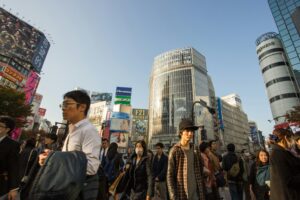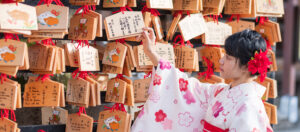Japan is a country of contrasts, where ancient traditions mesh seamlessly with cutting-edge technology. This is nowhere more evident than in its urban landscapes, which are as diverse as they are dynamic. From the neon-lit skyscrapers of Tokyo to the historic temples of Kyoto, each city has its own unique character and rhythm. This article takes you on a journey through urban Japan, unveiling the heart of its metropolises, exploring architectural marvels, and diving into the vibrant street life that defines city living in the Land of the Rising Sun.
Unveiling Urban Japan: The Heart of the Metropolis
In the heart of Japan’s sprawling urban landscapes, the metropolis beats with a rhythm that is both exhilarating and overwhelming. Tokyo, the capital city, stands as a testament to Japan’s post-war economic miracle, blending the ultra-modern with the traditional in a seamless tapestry. The city’s skyline is a kaleidoscope of architectural wonders, from the towering Tokyo Skytree to the historic Imperial Palace. Yet, amidst this bustling urban environment, pockets of tranquility can be found in the numerous gardens and shrines, offering a respite from the city’s relentless pace. The metropolis is also a hub of innovation, with state-of-the-art technology integrated into everyday life, from robotics to smart city initiatives. As the day gives way to night, the city transforms with its renowned nightlife, from the lively izakayas to cutting-edge nightclubs, showcasing the vibrant urban culture that pulses through the heart of Japan.
Exploring the Architectural Marvels of Tokyo
Tokyo’s skyline is a canvas of architectural innovation and diversity. The city’s buildings tell a story of Japan’s journey through the ages, from the serene Meiji shrines to the futuristic Mori Tower. Iconic structures like the Tokyo Tower and the newer Tokyo Skytree serve as symbols of the city’s continuous reach for the sky, while the Roppongi Hills and Shibuya Crossing illustrate the bustling urban life. Architects in Tokyo have masterfully blended functionality with aesthetic appeal, creating spaces that are both living art and hubs of activity. The city’s approach to sustainable building practices is evident in projects like the Mode Gakuen Cocoon Tower, emphasizing eco-friendly materials and energy efficiency. Tokyo’s architecture not only defines its skyline but also reflects the city’s resilience and adaptability, standing as a testament to Japan’s capacity for reinvention and innovation.
Osaka: Where Traditional Meets Contemporary
Osaka, Japan’s kitchen, offers a vibrant tapestry of traditional and contemporary culture. The city is renowned for its culinary scene, where street food vendors and Michelin-starred restaurants coexist, serving everything from takoyaki to exquisitely prepared sushi. Architecturally, Osaka blends the historic with the modern; the imposing Osaka Castle stands in stark contrast to the futuristic Umeda Sky Building, creating a skyline that is uniquely Osakan. The city’s lively Dotonbori district epitomizes Osaka’s vibrant urban life, with its neon lights and bustling crowds. Yet, amidst the modernity, traditional tea houses and public baths (sento) offer a glimpse into the city’s rich cultural heritage. Osaka’s blend of the old and the new creates a dynamic urban environment that is both welcoming and exhilarating to explore.
The Pulse of Kyoto: Ancient City with a Modern Twist
Kyoto, the heart of traditional Japan, is a city where the ancient and the contemporary coalesce in harmony. Known for its stunning temples, serene gardens, and traditional tea ceremonies, Kyoto offers a window into Japan’s spiritual and cultural history. The cityscape is dominated by historic landmarks such as Kinkaku-ji (the Golden Pavilion) and Fushimi Inari Shrine, with their timeless beauty attracting visitors from around the globe. Yet, Kyoto is also home to a burgeoning tech industry, with cutting-edge research centers and startups breathing new life into the ancient city. The juxtaposition of the old and the new is evident in Kyoto’s Gion district, where geishas in traditional attire can be seen walking past modern cafes and galleries. This blend of history and innovation makes Kyoto a fascinating urban environment, where the past informs the future.
Navigating the Bustling Streets of Yokohama
Yokohama, Japan’s second-largest city, is a bustling metropolis that seamlessly integrates international influences with a distinctly Japanese urban culture. The city’s port, one of the busiest in the world, serves as a gateway for cultural exchange, making Yokohama a melting pot of global and local traditions. The Minato Mirai district, with its cosmopolitan skyline, luxury shopping centers, and cultural facilities, epitomizes modern urban development. Yet, Yokohama retains a sense of its historical charm in the historic Yamate district, where foreign traders once resided. The city’s Chinatown, the largest in Japan, offers an array of authentic cuisines and traditional festivals, showcasing Yokohama’s diverse cultural fabric. With its blend of international dynamism and Japanese urbanity, Yokohama stands as a model of cosmopolitan living, offering a unique perspective on city life in Japan.
Sapporo: A Blend of Nature and Urban Lifestyle
Sapporo, the capital of Hokkaido, offers a unique urban experience, where the beauty of nature is never far from the city’s vibrant urban life. Famous for its annual Snow Festival, Sapporo is a city that embraces the outdoors, with its numerous parks and green spaces providing a natural counterbalance to the urban environment. The city’s layout, designed with the assistance of American and European urban planners, features wide, tree-lined boulevards and open spaces, making it one of Japan’s most livable cities. Sapporo’s culinary scene reflects its proximity to nature, with fresh seafood and locally-grown produce taking center stage. The city’s beer culture, highlighted by the historic Sapporo Brewery, adds another layer to its urban identity. Sapporo’s blend of natural beauty and urban sophistication creates a laid-back atmosphere that distinguishes it from Japan’s other major cities.
Fukuoka: The Gateway to Japan’s Southern Charm
Fukuoka, a dynamic city on the northern shore of Kyushu Island, is emerging as a gateway to Japan’s southern charm. With its vibrant food scene, highlighted by the famous Hakata ramen, and lively open-air food stalls (yatai), Fukuoka offers a culinary adventure that mirrors its warm and welcoming spirit. The city’s architecture, from the ancient Kushida Shrine to the modern Fukuoka Tower, reflects a blend of historical depth and contemporary flair. Fukuoka’s role as a cultural and economic bridge to Asia is evident in its cosmopolitan atmosphere and international events, attracting a growing number of global citizens. The city’s parks and beaches, including the popular Momochi Seaside Park, provide a refreshing escape from urban life, making Fukuoka an attractive destination for those seeking a balance between city living and nature.
The Nightlife of Nagoya: Japan’s Unsung Urban Gem
Nagoya, often overlooked in favor of Japan’s larger metropolises, offers an authentic urban experience that is rich in cultural and nightlife offerings. The city’s entertainment district, Sakae, is a hub for dining, shopping, and nightlife, with a variety of options that cater to every taste. From traditional izakayas serving local sake to trendy bars and clubs featuring international DJs, Nagoya’s nightlife scene is both diverse and vibrant. The city’s cultural scene is equally rich, with museums, galleries, and theaters offering a glimpse into both Nagoya’s history and its contemporary artistic endeavors. The Nagoya Castle, with its stunning architecture and historical significance, provides a backdrop to the city’s modern energy. As Japan’s fourth-largest city, Nagoya represents an urban experience that combines tradition with modernity, offering a unique perspective on Japanese city life.
Hiroshima: Resilience and Revival in the Modern Era
Hiroshima is a city that embodies resilience and revival. Known worldwide for the tragic events of 1945, Hiroshima has transformed itself into a symbol of peace and recovery. The Peace Memorial Park and Museum stand as poignant reminders of the past, while also serving as beacons of hope for the future. Hiroshima’s urban landscape is marked by wide boulevards and green spaces, reflecting the city’s commitment to creating a livable environment. The city’s culinary scene, particularly its oysters and okonomiyaki (Japanese savory pancake), offers a taste of Hiroshima’s rich cultural heritage. The vibrant downtown area, with its shopping arcades, restaurants, and entertainment venues, pulses with energy, showcasing the city’s successful transformation. Hiroshima’s story of resurgence continues to inspire, making it a compelling urban destination that speaks to the indomitable spirit of its people.
Kawasaki: Innovation and Industry in Harmony
Located between Tokyo and Yokohama, Kawasaki is a city where innovation and industry coexist in harmony. Known for its manufacturing base, Kawasaki has embraced cutting-edge technology to drive its economic and environmental initiatives. The city’s waterfront, once dominated by heavy industry, is being transformed into a vibrant commercial and recreational area, showcasing Kawasaki’s commitment to sustainable urban development. The Kawasaki Daishi Temple, a popular destination for tourists and locals alike, offers a spiritual counterpoint to the city’s industrial landscape. Kawasaki’s investment in green technology and smart city solutions is evident in its infrastructure, from renewable energy projects to advanced waste management systems. As a city that balances industrial heritage with forward-looking initiatives, Kawasaki exemplifies the potential for urban areas to innovate while remaining true to their roots.
Sendai: Urban Development Amidst Natural Beauty
Sendai, known as the City of Trees, is a testament to the harmonious coexistence of urban development and natural beauty. The city’s wide avenues, lined with zelkova trees, and its numerous parks and green spaces reflect a commitment to preserving nature within an urban environment. Sendai’s status as a commercial and educational hub in the Tohoku region has fostered a vibrant cultural scene, with festivals, concerts, and markets drawing both residents and visitors. The city’s culinary offerings, particularly its gyutan (beef tongue), highlight local flavors and agricultural produce. Sendai’s recovery and rebuilding efforts following the 2011 earthquake and tsunami have reinforced its resilience and community spirit. With its blend of natural beauty, urban vitality, and a forward-looking ethos, Sendai offers a model for sustainable city living in harmony with the environment.
The Future of Urban Japan: Trends Shaping City Living
As Japan faces the future, urban environments are at the forefront of change, driven by demographic shifts, technological advancements, and environmental considerations. Cities are embracing smart technology to improve infrastructure and services, from transportation to energy use, making urban living more efficient and sustainable. The trend towards more compact, mixed-use developments reflects a shift away from suburban sprawl, facilitating a lifestyle that is both convenient and eco-friendly. Cultural and creative industries are playing an increasingly important role in urban revitalization, turning cities into hubs of innovation and artistic expression. With the challenges of aging populations and climate change, Japan’s cities are also focusing on inclusivity and resilience, ensuring that urban living remains vibrant and adaptable for future generations. As Japan continues to innovate and adapt, its cities stand as dynamic examples of how tradition and modernity can coalesce to create thriving urban landscapes.
Urban Japan offers a fascinating journey through a land of contrasts, where ancient traditions and futuristic innovations coexist in vibrant, dynamic cities. From the historic streets of Kyoto to the bustling metropolises of Tokyo and Osaka, Japan’s urban centers are alive with energy, creativity, and resilience. Each city, with its unique blend of culture, architecture, and technology, tells a story of a nation that is constantly evolving while staying rooted in its rich heritage. As urban Japan continues to navigate the challenges and opportunities of the 21st century, it remains a compelling destination for those seeking to explore the complexities of city living in the modern world.





